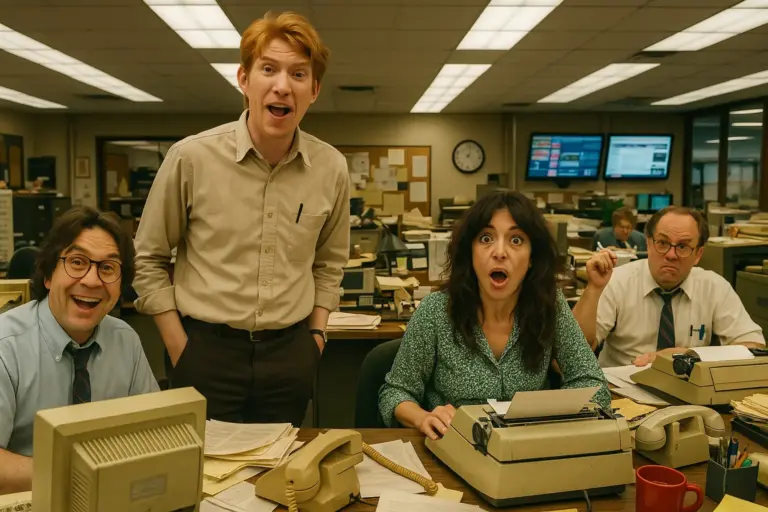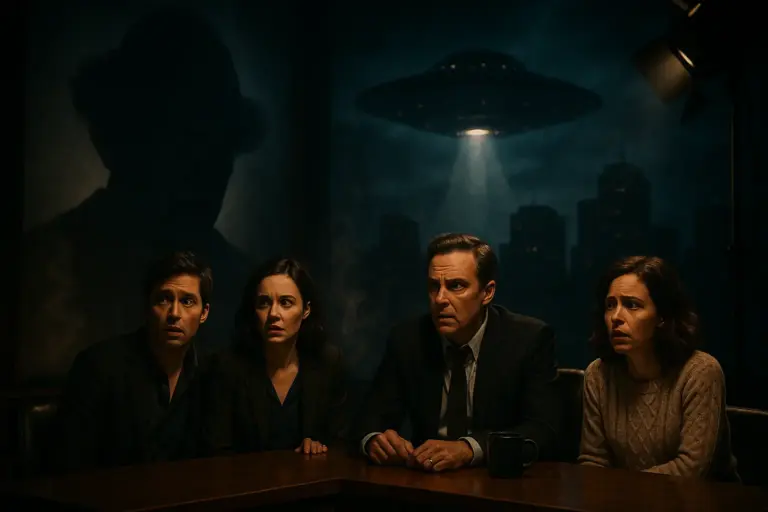In Buenos Aires, one of the world’s most storied cities, an invisible snowfall signals the start of an apocalypse. This is no ordinary snowstorm; instead, it’s a lethal, silent threat that strips life from the streets overnight. Released on Netflix on April 30, 2025, “The Eternaut” catapults viewers into this haunting vision. The six-episode Argentine sci-fi drama, directed by Bruno Stagnaro, draws its inspiration from the revered 1957 graphic novel by Héctor Germán Oesterheld and Francisco Solano López. As the first flakes fall, the series unfolds around Juan Salvo, played by Ricardo Darín, and his unlikely band of survivors. Together, they must navigate a Buenos Aires transformed into a ghostly labyrinth of loss, devastation, and the unknown.

A Landmark Adaptation Finally Hits the Screen
“The Eternaut” holds a special place in Latin American popular culture. For years, readers and critics have hailed the source graphic novel as a masterwork – a chilling allegory, a protest in the form of science fiction. The question loomed for decades: Could anyone do justice to this legendary tale in a screen adaptation? Now, with Netflix’s worldwide reach, audiences everywhere get to answer that question for themselves.
Critical Reception: High Praise Meets Subtle Doubt
Upon debut, expectations ran high, and so did the scores. “The Eternaut” notched a robust 93% approval rating on Rotten Tomatoes, albeit from a modest 14 critics’ reviews. Over on Metacritic, it landed a solid 72 out of 100. Those numbers tell a story: the majority of critics approved, yet a faction remained hesitant.
Still, numbers rarely capture the whole picture. The critical conversation quickly broke into factions. Many hailed the adaptation’s ambition, its eerie sense of place, and the mature way it handled disaster. Others, however, questioned whether its atmospheric style crossed over into the realm of sluggishness. In short, the show promptly ignited debate – not just about quality, but about entertainment itself.
What Works: The Shows’ Standout Qualities
Atmospheric Storytelling
Right from the early scenes, critics applauded how “The Eternaut” mined tension from silence and suspense. Instead of racing through exposition or relying on endless special effects, the show uses its slow pace to paint an atmosphere thick with dread and uncertainty. Every empty street and distant cry underline the horror of a city in shock. This approach takes guts – and it rewards patient viewers in spades.
Haunting Visuals and Cinematography
If Buenos Aires is the stage, then “The Eternaut” transforms it beyond recognition. Critics describe the camera as almost another character. It lingers over abandoned playgrounds, eerie streetcars, and billowing clouds of toxic snow, soaking the city in shimmering dread. The showrunners clearly set out to make the city feel both familiar and unnervingly alien; many agree they succeeded. The visual storytelling shines, pulling viewers deep into the story’s heart of darkness.
Sociopolitical Resonance
Few apocalyptic stories double as such nuanced reflections on recent history. “The Eternaut” draws much of its power from allegory – hints of Argentina’s cycles of tyranny, loss, and survival. Critics praised how the series weaves real-world fears and political subtext into its plot. It’s not just about fighting aliens but about resisting unseen forces, both literal and metaphorical. This gives the series an extra layer of depth rare in today’s sci-fi landscape.
Three Key Positive Points
- Riveting atmospheric tension enhances every scene.
- Striking cinematography delivers both beauty and terror.
- Deep allegory connects the science fiction to real Argentine history.
But Not All That Glitters: Where “The Eternaut” Stumbles
Slow Pacing
While atmosphere can draw some in, it can also turn others away. Many critics mention that the show’s opening episodes particularly unfold at a deliberate, sometimes glacial, pace. Some viewers found their patience tested as the story built mood over action. For fans who crave quick thrills or rapid plot twists, these early episodes may feel less engaging. The creators clearly chose to simmer rather than boil, but this may divide the audience sharply.
Character Development Misses the Mark
Another frequent critique surfaces around the cast. While Ricardo Darín’s performance gets nods for its subtlety, many critics contend that most secondary characters don’t receive enough attention. Their arcs feel thin, at times even disposable. This is especially noticeable as future episodes demand more emotional investment. When catastrophe strikes, the lack of depth makes it harder to care about anyone beyond Juan Salvo himself.
Lingering Questions and Frustrating Mysteries
Finally, some viewers have expressed dismay at certain unresolved plot elements. The show teases the motives and origins of its alien antagonists but never fully commits to answering. Ambiguity can add tension, but over-reliance on mystery can lead to confusion and frustration. Several critics suggested that, especially toward the finale, “The Eternaut” leaves viewers dangling without satisfying closure.
Three Key Negative Points
- Early episodes drag with a slow narrative build.
- Secondary characters remain underdeveloped.
- Major plot threads go unresolved, creating narrative frustration.
Transitioning Between Strength and Weakness
“The Eternaut” is, by every measure, a series built on contrasts. On one hand, its measured, atmospheric style gives it a power unlike most sci-fi on TV. On the other, the very elements that make it singular will alienate viewers who prefer more conventional storytelling. The show feels meticulously crafted, but at times, this raises the question of whether it prioritizes craft over connection.
Every episode immerses the audience in suffocating dread, from the stark white blanket of snow to the flickering neon and lost faces of Buenos Aires. The design choices echo the graphic novel’s original tone, but on screen, these choices often slow the pace. Instead of typical escalating action, tension ebbs and flows. Characters move cautiously, sometimes too cautiously, through haunted spaces that hold more mystery than resolution. The slow burn works for those hungry for subtext and atmosphere. It frustrates those after adrenaline and clarity.
Wide Reactions Across the Globe
With Netflix’s worldwide platform, “The Eternaut” introduces Argentine genre storytelling to new corners of the globe. Many international reviewers note the series’ willingness to take risks. The artistry and the focus on mood and political allegory set it apart from Hollywood’s current sci-fi palette. Yet, some American and European critics point out that unfamiliar viewers might find it hard to connect to the regional subtext and understated character work.
Audience reactions follow suit. While hardcore fans of the source material hail the series as a triumph – finally, the adaptation long promised!—others log on to review forums in search of faster payoffs. Social feeds fill with debates: Is slow-burning tension genius, or is it just slow?
Viewer Ratings and Ongoing Popularity
Numbers tell part of the story. With over 93% approval from critics on Rotten Tomatoes and a healthy Metacritic score, most early reviews tilt positive. On fan forums, informal polls put satisfaction closer to 7 out of 10, indicating strong appreciation, yet also room for improvement. Netflix responded to the buzz by swiftly renewing the show for a second season, showing faith in its audience’s appetite for more.
Final Thoughts Before the Verdict
“The Eternaut” stands as one of 2025’s most talked-about genre debuts because it dares to be different. Director Bruno Stagnaro and his creative team ignite discussion as much through restraint as spectacle. Drawing from history and spinning allegory, the series becomes as much about mood and memory as it is about aliens and action. Viewers must decide: do they want entertainment that burns slowly but brightly, or do they want a show that leaps from crisis to climax?
Before rendering a verdict, let’s crystallize the essence. The show delivers rare atmosphere, visual poetry, and rich metaphor, occasionally at the expense of speed and character depth. It rewards patience and close attention yet punishes those hungry for immediate catharsis.
Verdict: The Eternaut BRNG?
After sifting through critical praise and critique, it becomes clear that “The Eternaut” is not a series for everyone. It is far from mindless or empty, but it sometimes edges dangerously close to the territory that some might call ‘boring’. The slow burn – though artful – divides viewers. The visuals and sociopolitical undercurrents elevate the narrative above much of contemporary fare. Yet, the absence of swift pacing and a lack of deep investment in each character means that the show may bore some, especially those searching for non-stop action.
So where does it land on the scale? For originality, mood, and ambition, it scores high marks. For universal appeal and entertainment speed, it loses a few points. Altogether, the numeric assessment:
Final Score: 6.8 / 10
If you value tension, metaphor, and atmosphere over action, “The Eternaut” will keep you hooked. If you want your post-apocalyptic thrillers fast and furious, you may be tempted to look elsewhere. Ultimately, this is a series to watch with patience – and maybe a warm blanket, just in case the snow starts to fall.





